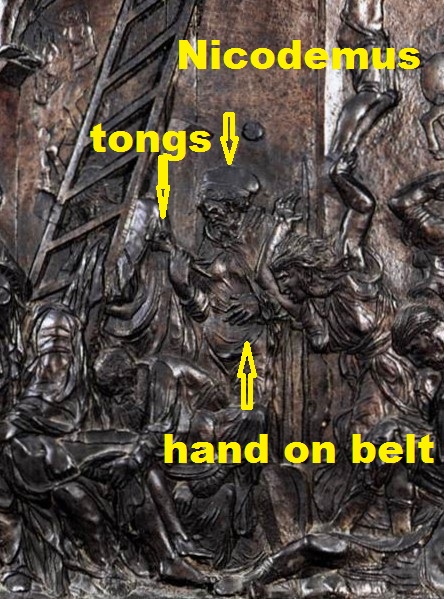The last blog entry treated the site and context for the 1463 Lamentation by Niccolo dell'Arca.
Here I would like to suggest three things:
1-DONATELLO's influence on Niccolo's Lamentation
2-NICCOLO's influence on the Della Robbia in La Verna
3-NICCOLO's influence on De Roberti's Magdalene painted 1475-85 in Bologna
1)Niccolo's dell'Arca's presentation of the Compianto (Lamentation) is such a vivid and dramatic
reworking of the story told for many centuries before his opus that it is intriguing to wonder
where he got the ideas for the seven sculpted figures and their passionate expressions. Many
painters and sculptors represented the Deposition (the taking down of Christ's body off
the cross), the Entombment (the laying of his body in the tomb), the Pieta (Mary with her
son's body) and the Lamentation (a group of mourners around the supine body of Christ) in the
centuries that preceded Niccolo dell'Arca, and it is possible, since he was originally from Bari,
that he saw many of these representations on his travels around Italy for work. But the sculpted
versions that are closest in tenor, feeling, and in arrangement of figures' bodies are to be found
in the late works of the Florentine sculptor DONATELLO, whose last years, 1460-66, overlap with the date given for Niccolo's Lamentation, 1463.
Towards the end of his life, 1460-65, (he dies in 1466) Donatello is working on bas-reliefs in bronze for two pulpits in the church of San Lorenzo in Florence.

As is his usual modus operandi (mode of operation) he takes the quite common theme of the last days of Christ's life (the Passion) and gives it original compositions and twists. For instance, in his DEPOSITION made for the pulpit he imagines the three crosses, that of Christ and the two thieves (good and bad) sticking out of the picture plane at the top as the viewer looks up at the feet of the two thieves and down at the body of Christ, who has already been laid out on his mother's lap.
The scene is tumultuous, filled with Roman soldiers on horseback, followers of Christ, and new
converts. The ladder in the center reaches beyond the picture plane to Christ's cross whose foot-ledge
is barely visible. But if we look closely we can find the Madonna at the bottom of the ladder,
Nicodemus to the right and below him, rushing in from the right, Mary Magdalene, her arms raised
and her hair flying. The air pressing on her clothing reveals her body under the drapery and gives the
viewer the sense of her urgency.
She rushes in in much the same way we see her in dell'Arca's scene, her eyes focusing on Christ's feet.
 Easier to see in a drawing because
Easier to see in a drawing becausethe bronze is so dark.
Nicodemus in Donatello's bronze holds the tongs in the right hand, instead of the hammer, but he reaches for his belt, where he intends to secure the tongs since he has finished removing the nails.
Nicodemus' tools and hand gestures are very similar in the dell'Arca Lamentation:
Lamentation.
The idea that mourners are so torn up by grief that they rush around wildly is sculpted on an earlier occasion by Donatello in his Entombment 1447-50, made for the high altar of Sant'Antonio in Padua:
Christ's right hand is placed over his left, as in Dell'Arca's dead body:
Giotto's (1305) and Angelico's (1434) Lamentation scenes seem calm in comparison with the riveting
grief of the women in Donatello's and Dell'Arca's sculptures:


Niccolo dell'Arca could have seen Donatello's high altar panel of 1447-50 in Padua as well as the
panel of the Deposition from the pulpit in Florence, dated between 1460-65, before undertaking the
Nicodemus and two far right Maries in his own Lamentation of 1463.
The heightened urgency of the women, as well as the emphasis on the emotional outpouring of their grief seem both to be taken from Donatello's late compositions. Dell'Arca doesn't repeat the raised arms of the women. But he tucks the tongs into the belt of Nicodemus so we won't suspect he has substituted his hammer in the location where the master Florentine sculptor had placed Nicodemus' tongs.
Even Dell'Arca's St. John the Evangelist seems to have been lifted from Donatello's St. John in
an earlier bas-relief of the Pieta for the same altar in Sant'Antonio in Padua, 1447-50:

2) The hand of John holding up his head goes on to influence one of the Della Robbias (probably Giovanni) in his Behold the Man (Ecce Uomo) in an altar relief done for the Franciscan church complex at La Verna in northern Tuscany:
St. John on the right cradles his chin with his right hand while holding Christ's left arm in his other
hand. Dates for this glazed bas-relief vary from 1480 to 1490, but well after Niccolo dell'Arca's
Lamentation of 1463.
In the same group of churches decorated to honor St. Francis' receiving the stigmata
we find a Deposition by Andrea della Robbia of 1515; the figures are restrained compared to Dell'Arca's, 

but Christ's body is supine in much the same way as his and Christ's right arm is placed over his left, just as in the Bolognese work:

The monks at La Verna did not want to be riled up by females wildly rushing in to view
Christ's body; they were not the flagellants of Dell'Arca's Bologna church.


But the date of the painting precludes it being an influence on the sculptor. The painter has clearly
been influenced by Niccolo dell'Arca's figure of Magdalene of 1463 and not the other way around.
























No comments:
Post a Comment